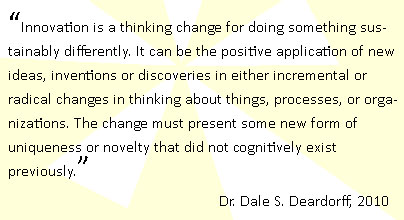


Basics of Innovation Session:
The Basics of Innovation RPLC Accelerated Learning Share-Module is a Team and Leader based methodology structured to introduce the key concepts of Innovation and Creativity thru a reading tutorial completed offline prior to a 4 hour facilitated intervention.
The history of Innovation and describing its basics depend on where you’re standing in your organizations evolution timeline.
"All innovation begins with creative ideas . . . We define innovation as the successful implementation of creative ideas within an organization. In this view, creativity by individuals and teams is a starting point for innovation; the first is necessary … for the second". Amabile et al. (1996)
Describing “Innovation”:
- Product Innovation
- Process Innovation
- Transformational Innovation
- Incremental Innovation
- Break thru Innovation
- Radical Innovation
- Corporate Innovation
- Organizational Innovation
With everyone now involved in innovation and a continuous stream of articles, blog posts and books being published on the topic, we need to be sure we are clear on the basics of innovation, particularly corporate or organizational innovation.
Explain the History of Velcro story:
For thousands of years, man has walked through fields of weeds and arrived home with burrs stuck to his clothing. In 1948 George de Mestral, a Swiss engineer, returned from a walk and found some cockleburs clinging to his cloth jacket. When de Mestral loosened them, he examined one under his microscope. The principle was simple. The cocklebur is a maze of thin strands with burrs (or hooks) on the ends that cling to fabrics or animal fur.
By the accident of the cockleburs sticking to his jacket, Mestral recognized the potential for a practical new fastener. It took eight years to experiment, develop, and perfect the invention, which consists of two strips of nylon fabric. One strip contains thousands of small hooks. The other strip contains small loops. When the two strips are pressed together, they form a strong bond
There are three Innovation interlocking components:
- Insight or inspiration suggesting an opportunity to do something different to create value
- An idea or plan to build an offering based on that insight or inspiration
- The translation of that plan into a successful business commercialization
Each of these components carries significant and different complexity, but more often than not, they cover the basics of innovation.
99.9% of corporate innovation is organizational in nature. Innovation is almost never the result of a single scientist having an aha moment and single-handedly implementing it. Rather, innovation is the result of collaborative creativity in terms of devising and developing an idea into a viable concept, followed by a collaborative effort to turn that concept into reality and implement it as a product, service or process improvement. In the corporate context, innovation can be defined as the profitable implementation of creative ideas.
Profitable implementation means that the ideas, once implemented, have to deliver positive value to the organization. For instance, a new product will generate additional income for the company; a process improvement will reduce operational costs and therefore increase profitability. Although non-profit organizations and governments are, by definition, non-profit, the same notion holds true. A charity can be innovative - for example - by devising ways to deliver food aid to people more cost effectively. This increases its profitability. However, because it is a charity, that profit is returned to the organization and enables it to help more people.
In some cases, innovation does not provide a clear and direct path to profitability. However, it will add value to the organization or its customers and that indirectly profits the organization. For instance, an improved method of providing customer service may not reduce costs, but may make customers happier. Hence, value is realized. Moreover, happier customers are likely to buy more often and recommend you to others. This, of course, is beneficial to profitability.
For more information on cost and event booking, email RPLC
